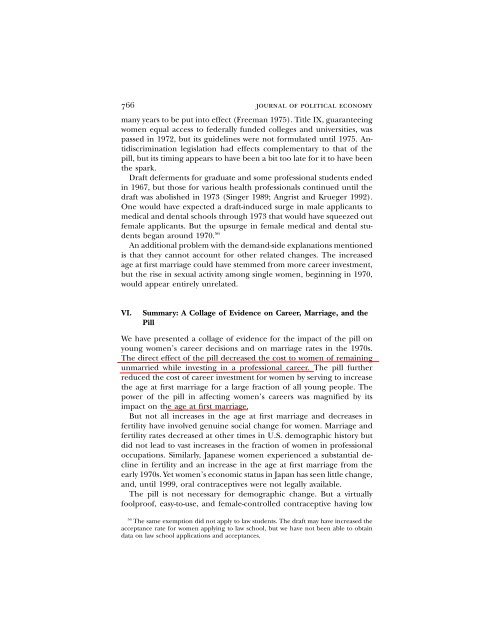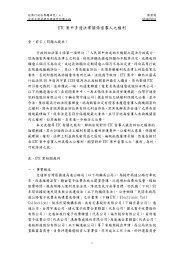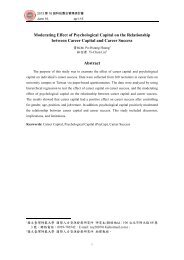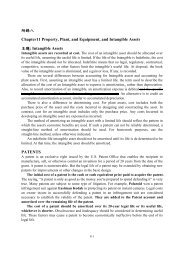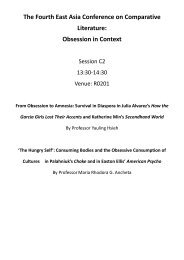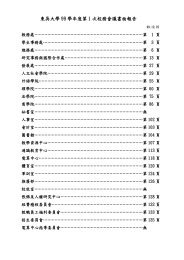The Power of the Pill: Oral Contraceptives and Women's ... - Mail
The Power of the Pill: Oral Contraceptives and Women's ... - Mail
The Power of the Pill: Oral Contraceptives and Women's ... - Mail
You also want an ePaper? Increase the reach of your titles
YUMPU automatically turns print PDFs into web optimized ePapers that Google loves.
766 journal <strong>of</strong> political economy<br />
many years to be put into effect (Freeman 1975). Title IX, guaranteeing<br />
women equal access to federally funded colleges <strong>and</strong> universities, was<br />
passed in 1972, but its guidelines were not formulated until 1975. Antidiscrimination<br />
legislation had effects complementary to that <strong>of</strong> <strong>the</strong><br />
pill, but its timing appears to have been a bit too late for it to have been<br />
<strong>the</strong> spark.<br />
Draft deferments for graduate <strong>and</strong> some pr<strong>of</strong>essional students ended<br />
in 1967, but those for various health pr<strong>of</strong>essionals continued until <strong>the</strong><br />
draft was abolished in 1973 (Singer 1989; Angrist <strong>and</strong> Krueger 1992).<br />
One would have expected a draft-induced surge in male applicants to<br />
medical <strong>and</strong> dental schools through 1973 that would have squeezed out<br />
female applicants. But <strong>the</strong> upsurge in female medical <strong>and</strong> dental students<br />
began around 1970. 56<br />
An additional problem with <strong>the</strong> dem<strong>and</strong>-side explanations mentioned<br />
is that <strong>the</strong>y cannot account for o<strong>the</strong>r related changes. <strong>The</strong> increased<br />
age at first marriage could have stemmed from more career investment,<br />
but <strong>the</strong> rise in sexual activity among single women, beginning in 1970,<br />
would appear entirely unrelated.<br />
VI.<br />
Summary: A Collage <strong>of</strong> Evidence on Career, Marriage, <strong>and</strong> <strong>the</strong><br />
<strong>Pill</strong><br />
We have presented a collage <strong>of</strong> evidence for <strong>the</strong> impact <strong>of</strong> <strong>the</strong> pill on<br />
young women’s career decisions <strong>and</strong> on marriage rates in <strong>the</strong> 1970s.<br />
<strong>The</strong> direct effect <strong>of</strong> <strong>the</strong> pill decreased <strong>the</strong> cost to women <strong>of</strong> remaining<br />
unmarried while investing in a pr<strong>of</strong>essional career. <strong>The</strong> pill fur<strong>the</strong>r<br />
reduced <strong>the</strong> cost <strong>of</strong> career investment for women by serving to increase<br />
<strong>the</strong> age at first marriage for a large fraction <strong>of</strong> all young people. <strong>The</strong><br />
power <strong>of</strong> <strong>the</strong> pill in affecting women’s careers was magnified by its<br />
impact on <strong>the</strong> age at first marriage.<br />
But not all increases in <strong>the</strong> age at first marriage <strong>and</strong> decreases in<br />
fertility have involved genuine social change for women. Marriage <strong>and</strong><br />
fertility rates decreased at o<strong>the</strong>r times in U.S. demographic history but<br />
did not lead to vast increases in <strong>the</strong> fraction <strong>of</strong> women in pr<strong>of</strong>essional<br />
occupations. Similarly, Japanese women experienced a substantial decline<br />
in fertility <strong>and</strong> an increase in <strong>the</strong> age at first marriage from <strong>the</strong><br />
early 1970s. Yet women’s economic status in Japan has seen little change,<br />
<strong>and</strong>, until 1999, oral contraceptives were not legally available.<br />
<strong>The</strong> pill is not necessary for demographic change. But a virtually<br />
foolpro<strong>of</strong>, easy-to-use, <strong>and</strong> female-controlled contraceptive having low<br />
56<br />
<strong>The</strong> same exemption did not apply to law students. <strong>The</strong> draft may have increased <strong>the</strong><br />
acceptance rate for women applying to law school, but we have not been able to obtain<br />
data on law school applications <strong>and</strong> acceptances.


